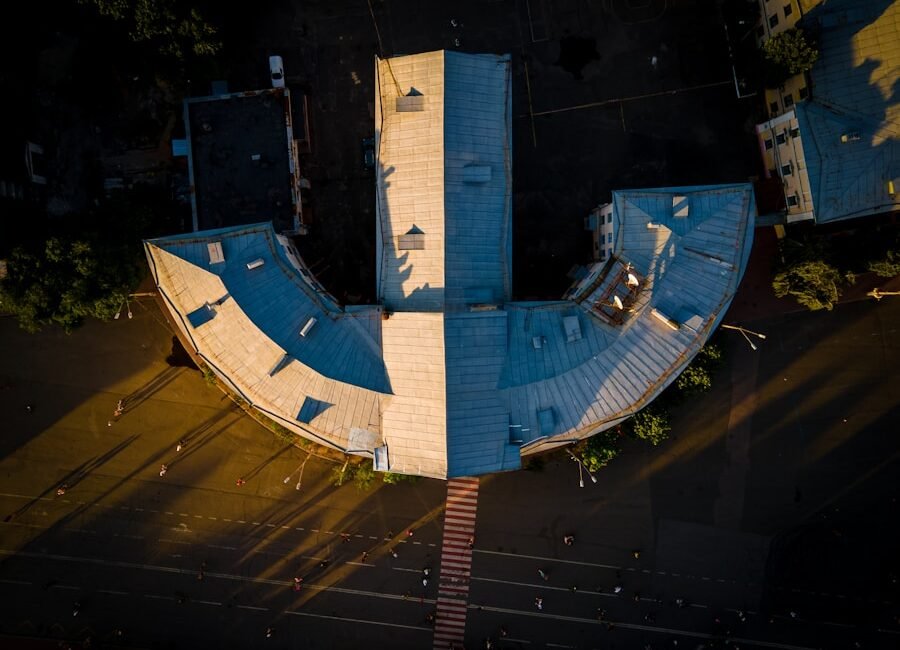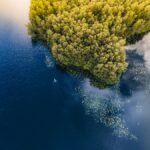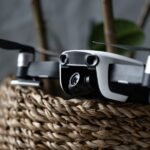Aerial photography with drones has become increasingly popular in recent years, thanks to the accessibility and affordability of drone technology. Drones, also known as unmanned aerial vehicles (UAVs), are equipped with cameras that can capture stunning aerial shots from unique perspectives. Understanding the basics of aerial photography with drones is essential for capturing high-quality images and videos.
One of the key factors to consider when getting started with aerial photography is the type of drone to use. There are various types of drones available on the market, ranging from consumer-grade models to professional-grade ones. Consumer-grade drones are typically more affordable and easier to operate, making them ideal for beginners. On the other hand, professional-grade drones offer advanced features and capabilities, such as higher resolution cameras and longer flight times, making them suitable for more experienced photographers.
In addition to choosing the right drone, it’s important to familiarize yourself with the basic principles of aerial photography, such as composition, lighting, and framing. Aerial photography presents unique challenges compared to traditional photography, as you have to consider factors such as altitude, angle, and distance from the subject. By understanding these basics, you can capture stunning aerial shots that stand out from the rest.
Mastering Camera Settings and Techniques for Stunning Aerial Shots
Once you have a good understanding of the basics of aerial photography with drones, it’s time to master camera settings and techniques to capture stunning aerial shots. Drones are equipped with cameras that offer a range of settings and features, allowing you to customize your shots to achieve the desired results.
One of the most important camera settings to consider when capturing aerial shots is the exposure. Adjusting the exposure settings can help you achieve the right balance of light and shadow in your images, especially when shooting in different lighting conditions. Additionally, mastering techniques such as adjusting the shutter speed and aperture can help you capture sharp and well-exposed aerial shots.
Another important aspect of mastering camera settings for aerial photography is understanding the different shooting modes available on your drone. Most drones offer a range of shooting modes, such as auto mode, manual mode, and various scene modes. By experimenting with these modes and understanding how they affect your shots, you can enhance your aerial photography skills and capture stunning images from unique perspectives.
In addition to camera settings, mastering techniques such as framing and composition is essential for capturing stunning aerial shots. Aerial photography offers a unique opportunity to capture landscapes and subjects from a bird’s eye view, allowing you to create visually striking images that stand out from traditional ground-level photography. By mastering these camera settings and techniques, you can take your aerial photography skills to the next level and capture stunning images that showcase the beauty of the world from above.
Utilizing Advanced Flight Modes and Maneuvers for Dynamic Perspectives
In addition to mastering camera settings and techniques, utilizing advanced flight modes and maneuvers can help you capture dynamic perspectives in your aerial photography. Drones are equipped with a range of flight modes and features that allow you to capture unique angles and perspectives that would be difficult or impossible to achieve with traditional photography.
One of the most popular flight modes for capturing dynamic perspectives is the point of interest mode, which allows you to lock onto a specific subject or location and orbit around it while keeping it in the center of the frame. This mode is ideal for capturing stunning aerial shots of landmarks, buildings, and natural landscapes from a dynamic perspective.
Another advanced flight maneuver that can enhance your aerial photography is the use of intelligent flight modes, such as follow me mode and waypoint navigation. Follow me mode allows the drone to automatically follow and track a moving subject, while waypoint navigation allows you to pre-program a flight path for the drone to follow, allowing you to capture dynamic aerial shots with precision and control.
In addition to advanced flight modes, mastering manual flight maneuvers such as flying in different patterns and angles can help you capture dynamic perspectives in your aerial photography. By experimenting with different flight modes and maneuvers, you can push the boundaries of traditional photography and capture stunning aerial shots that showcase the world from unique and dynamic perspectives.
Incorporating Filters and Lenses for Enhanced Aerial Photography
Incorporating filters and lenses can enhance your aerial photography by allowing you to capture stunning images with enhanced clarity, color, and depth. Filters are accessories that can be attached to the camera lens of your drone to modify the light entering the lens, while lenses are interchangeable accessories that can be used to achieve different focal lengths and perspectives.
One of the most popular types of filters for aerial photography is the polarizing filter, which helps reduce glare and reflections from surfaces such as water and glass, resulting in images with enhanced color saturation and contrast. Additionally, neutral density filters can be used to reduce the amount of light entering the lens, allowing you to achieve longer exposure times and capture motion blur in your aerial shots.
In addition to filters, incorporating lenses such as wide-angle lenses and telephoto lenses can enhance your aerial photography by allowing you to achieve different perspectives and focal lengths. Wide-angle lenses are ideal for capturing expansive landscapes and large subjects from a broad perspective, while telephoto lenses are ideal for capturing distant subjects with enhanced detail and clarity.
By incorporating filters and lenses into your aerial photography toolkit, you can enhance your ability to capture stunning images from unique perspectives with enhanced clarity, color, and depth. Experimenting with different filters and lenses can help you push the boundaries of traditional photography and capture breathtaking aerial shots that stand out from the rest.
Exploring Editing and Post-Processing Techniques for Professional Results
Exploring editing and post-processing techniques is essential for achieving professional results in your aerial photography. While capturing high-quality images with your drone is important, editing and post-processing can help enhance your images by adjusting exposure, color balance, sharpness, and other aspects to achieve the desired results.
One of the most popular editing software for aerial photography is Adobe Lightroom, which offers a range of tools and features for adjusting exposure, color balance, contrast, and other aspects of your images. Additionally, Adobe Photoshop is another popular software for editing aerial photos, offering advanced tools for retouching, compositing, and enhancing images with creative effects.
In addition to editing software, exploring post-processing techniques such as HDR (high dynamic range) imaging can help you achieve professional results in your aerial photography. HDR imaging involves combining multiple exposures of the same scene to achieve a wider dynamic range of tones in your images, resulting in stunning photos with enhanced detail in both highlights and shadows.
By exploring editing and post-processing techniques for aerial photography, you can enhance your images by adjusting exposure, color balance, sharpness, and other aspects to achieve professional results that stand out from the rest. Experimenting with different editing software and techniques can help you push the boundaries of traditional photography and capture breathtaking aerial shots that showcase the beauty of the world from above.
Navigating Legal and Safety Considerations for Aerial Photography with Drones
Navigating legal and safety considerations is essential for conducting aerial photography with drones in a responsible manner. As drones become increasingly popular for capturing stunning aerial shots, it’s important to be aware of the regulations and guidelines set forth by aviation authorities and government agencies to ensure safe and legal operation of drones for photography purposes.
One of the most important legal considerations for aerial photography with drones is obtaining the necessary permits and permissions for flying in certain areas or capturing images of certain subjects. Many countries have regulations in place that restrict or prohibit flying drones in certain areas such as airports, national parks, or densely populated areas. Additionally, capturing images of certain subjects such as private property or individuals may require obtaining consent or permissions from relevant authorities or individuals.
In addition to legal considerations, navigating safety considerations is essential for conducting aerial photography with drones in a responsible manner. Drones are capable of flying at high altitudes and speeds, making them potentially hazardous if not operated safely. It’s important to be aware of safety guidelines such as maintaining line of sight with the drone at all times, avoiding flying near people or animals, and conducting pre-flight checks to ensure the drone is in good working condition.
By navigating legal and safety considerations for aerial photography with drones, you can ensure that you are operating in a responsible manner that complies with regulations and guidelines set forth by aviation authorities and government agencies. Being aware of legal and safety considerations is essential for conducting aerial photography with drones in a safe and responsible manner that respects the privacy and safety of others.
Leveraging Aerial Photography for Various Industries and Applications
Leveraging aerial photography for various industries and applications offers a range of opportunities for photographers to showcase their skills and creativity in capturing stunning images from unique perspectives. Aerial photography has become increasingly popular across various industries such as real estate, construction, agriculture, tourism, environmental conservation, and more.
One of the most popular applications of aerial photography is in real estate marketing, where stunning aerial shots can showcase properties from unique perspectives that traditional ground-level photography cannot achieve. Aerial photography allows real estate agents to capture expansive views of properties, highlight surrounding amenities such as parks or waterfronts, and showcase properties in a visually striking manner that attracts potential buyers.
In addition to real estate marketing, leveraging aerial photography in construction offers opportunities to capture progress photos of construction sites from unique perspectives that showcase the scale and scope of projects. Aerial photography allows construction companies to monitor progress, identify potential issues or hazards, and showcase completed projects in a visually striking manner that highlights their capabilities.
Furthermore, leveraging aerial photography in agriculture offers opportunities to monitor crop health, identify potential issues such as pests or diseases, and optimize farming practices by capturing images from unique perspectives that provide valuable insights into crop conditions. Aerial photography allows farmers to make informed decisions about irrigation, fertilization, pest control, and other aspects of crop management by providing visual data that traditional ground-level methods cannot achieve.
By leveraging aerial photography for various industries and applications, photographers can showcase their skills and creativity in capturing stunning images from unique perspectives that provide valuable insights into different fields such as real estate marketing, construction monitoring, agriculture management, environmental conservation efforts, tourism promotion, and more. Aerial photography offers a range of opportunities for photographers to push the boundaries of traditional photography by capturing breathtaking images that showcase the beauty of the world from above.








